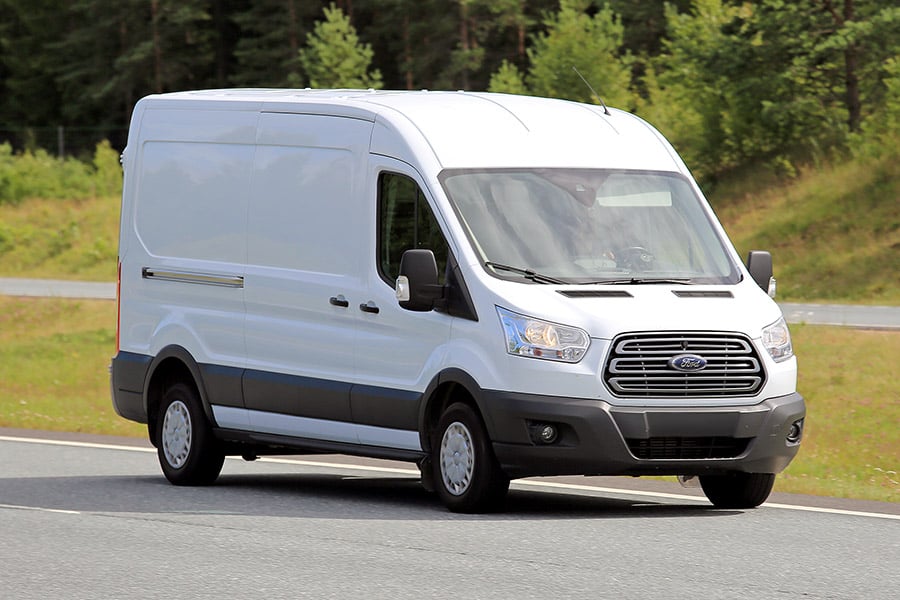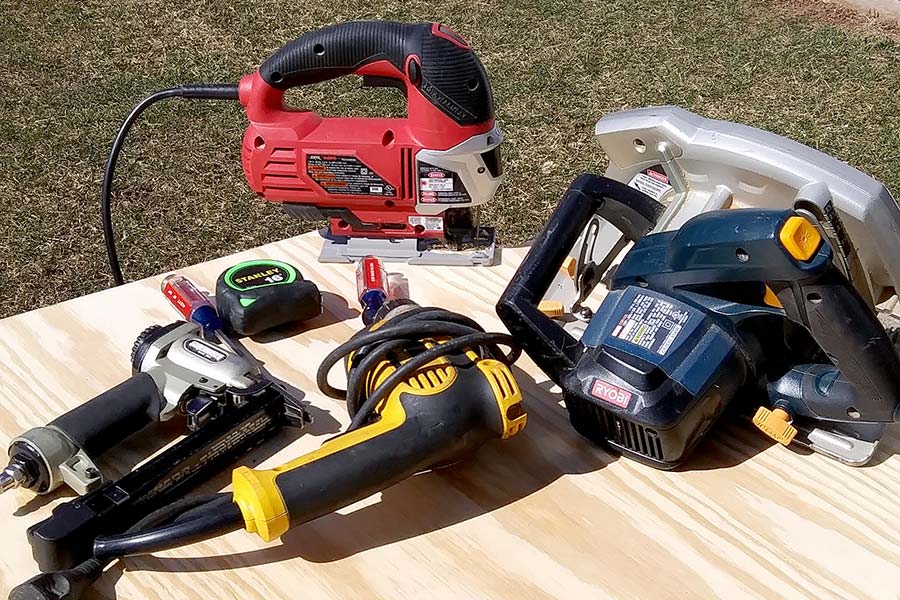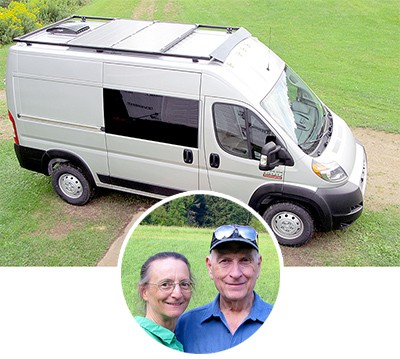
Cruising across the country in a camper is a dream that many people have, but they can’t handle the big price tag that comes along with buying one. In fact, according to the RV Industry Association (RVIA), there are nearly 40 million recreational vehicle owners. Because the thought of traveling unhindered is so appealing, many have begun creating their campers from Transit vans for a fraction of the cost.
How do you convert a Transit van into a camper? You can convert a Transit van into a camper if you have the proper tools, time, and resources. Here are the steps you need to follow:
- Plan
- Purchase a van
- Decide if you’re going to purchase a pre-made kit
- Make sure you have the proper tools
- Research insurance requirements
- Purchase the necessary materials
It can be an overwhelming task, so you might want to work on the project with someone that has experience with converting a van into a camper.
This post will be your ultimate guide for converting a Transit van into a camper. Read on to find out the materials you need as well as the steps necessary for a successful conversion.
Steps to Convert a Transit Van into a Camper
Before you can begin your conversion, you must figure out how to proceed. Here are the steps you will need to take to complete the project.
1. Plan
- Do NOT go into this project blindly because it will likely not end well and could end up costing you a pretty significant amount of cash, and it can be extremely stressful.
- This includes finding an appropriate space to work in. This project could be quite lengthy. Therefore, you will want an area where you can leave materials out so you can easily access them. You also need to consider the weather. It would be easiest to find an indoor location to work.
2. Purchase a Transit van.
3. Decide if you are gonna use a conversion kit or complete the project completely DIY.
4. Make sure you have the proper power tools.
5. Determine the requirements to ensure your camper will be insurable.
- Talk to an insurance agent and write things down. This is an area where you must be specific. If you can’t insure your camper, you may not be able to use it as planned.
- Be open with the agent and tell them precisely what you are doing and what your plans are.
- This will help them to guide you toward making your camper legal.
6. Get the materials you will need to complete the conversion.
- As you are working, you may determine things that need to be purchased as you go, but it is best to have all the high ticket materials ahead of time.
When you are preparing to convert your Transit van, do your research about what to include in your layout.
While you want your camper to be unique, you also want it to be functional. See what other people have done and personalize your plan from those ideas.
What Tools Do I Need?

Converting a Transit van to a camper requires lots of work and construction. You will need to have the proper tools to safely and accurately convert your van. Because you are adding to the van, you will likely not need any heavy-duty tools because you aren’t adjusting the frame of the vehicle at all. The scope of the tools required will fall into the category of home tools.
Some of the tools recommended for a van conversion include:
Saw
- a circular saw and jigsaw would work best for a project like this because you will be cutting different kinds of materials such as flooring, wood for walls, and boards for cabinets, etc.
Measuring and Leveling tools
- These are going to be very important because accurate measurements are crucial to your success with the build. Remember: to insure the camper, you must meet the requirements set forth. And the golden rule for any building project is to measure twice and cut once!
Clamps
- You will want a variety of sizes when it comes to clamps. There will be various parts that need to be held together as you are working.
Head Lamp
- When working in a van, you will quickly realize there are limited light resources and small areas that need your attention. A headlamp, although not required, could prove to be very useful.
Drill
- A powered drill is going to help you with this project. You are drilling through a variety of materials, so you need to make sure you have a durable drill that will handle the task.
Drill Bits
- Don’t try to use ordinary wood drill bits for this project. When you are working with steel or metal, standard drill bits will be destroyed very quickly. Purchase a drill bit specifically made to use on steel or metal, and that is sharp, not dull, it will save you both time and frustration. Not to mention the motor of your drill will thank you.
Miscellaneous Tools
- You may find yourself in need of other tools that, while not required, could make the job easier to complete. Some of those tools may include saw horses, electric sander, stapler, or even smaller precision type saws.
No matter what, you need to factor in the tools that you believe you will need the most, especially if you are on a tight budget with this project. You may also be able to check into renting some of the tools if you aren’t willing to commit to owning them after the camper conversion is complete.
Other Posts of Interest
- Do Camper Vans Hold Their Value?
- Our Favorite Van Camping Binoculars
- Camping Gas vs. LPG: Is There A Difference?
Where to Start
After you have a precise plan and all your materials gathered, you are ready to begin the process, which can seem quite overwhelming. Here is one progression you can follow that may be helpful.
- Start with the adjustments that need to be made to the body. If you are adding windows, vents, or anything that has to with the actual vehicle body, this is the starting point.
- Once the van is cleared of seats and panels (basically it is an empty metal box), if you are running wiring or any plumbing, you will need to do this before you cover with insulation.
- Then you will insulate the floor and put the flooring down. It is easier to add amenities with the floor already in place. You may want to cover the floor with drop cloths or a protective layer while you work on the rest of the van.
- Add soundproofing and insulation to the van. This is critical since it will help ensure the comfort of your camper.
- Add your chosen amenities such as tables, cabinets, beds, and any other options you would like to build in.
- If you are putting in sinks or any electrical items like lights, stoves, etc., this is the time to add those things in.
- Put the finishing aesthetic touches on your camper because it should now be ready to use.
We also have a post “How to Sleep In A Transit Van: Everything You Will Need” that will provide you with more information.
This list is a simplified step-by-step progression that you will follow. Although it looks quite straightforward, each of the steps can take several days or weeks. When you are working on anything body-related, be sure you know what you are doing. This may be an area to ask an expert to help. The same goes for plumbing or electrical work.
Why Should You Convert a Transit Van into a Camper?
Converting a Transit van into a camper is a great way to enjoy the RV lifestyle without the hefty price tag. If you are a fan of DIY projects and have the resources and time to commit, this may be an excellent project for you. So, why do people choose to convert Transit vans into campers?
- It provides you a cost-effective way to enjoy the camper lifestyle.
- You can customize the camper any way you would like to.
How Much Does It Cost?
The cost of converting a Transit van to a camper varies. If you are looking at a basic conversion with the essentials, you may be looking at a few hundred dollars. However, if you are planning to complete a luxury conversion with all the bells and whistles, you may have thousands of dollars in expenses.
Some of the factors that will determine the cost are:
- The cost of the van you purchase.
- The amenities you choose to include.
- The amount of labor you need to hire out.
- The materials you need to purchase or rent.
How Long Will The Conversion Take?
When choosing to convert a Transit van to a camper, the timeline will vary from project to project.
If the conversion includes adding several extras, the time required may be lengthy. If the conversion is minimal, the timeline will likely be much shorter. Other elements to take into consideration are the availability of parts as well as the time you can devote to completing the conversion.
The average time to complete the conversion is typically between 4-6 weeks. When determining a timeline, it is essential to factor in your experience level. If this is new territory, it will likely take more time.
However, if you have the help of an expert, the completion time will be shortened.
Insurance Regulations

While converting a Transit van to a camper may be simple enough to do, you also must make sure you have proper insurance on the vehicle. Insuring a Transit van or a camper as a manufacturer makes them is not an issue, but when you have a DIY project, insurance companies view it differently.
When searching for insurance, the first thing you need to determine is the purpose of your camper. Will you be living in the camper full time? Will you be storing the camper and using it seasonally? No matter the answer, you need to make sure you are truthful with the insurance company. Falsifying information will not be looked upon fondly if it is discovered.
Next, you will find questions that need to be answered when looking at insurance for your DIY camper.
- Can a camper be considered a permanent home?
Many people choose to live in their campers as full-time residences. Most insurance carriers will not insure a camper van as a full-time residence and only extend coverage to individuals that have a primary residence.
To be insured, the recreational vehicle must be built to the standards required by the US Department of Housing and Urban Development. If the vehicle doesn’t meet these standards, it’s not possible to obtain insurance.
- Is it a camper or a van?
You may be questioning the exact title by which to register your camper van. Technically it is a van, but because the van has been converted to a camper, it is required to be registered as a recreational vehicle.
Before attempting to register the converted van, it is crucial to make sure it meets the proper standards.
When looking into insurance regulations for your camper DIY, you need to be specific about the state you live in, because the laws vary by state. Unfortunately, there isn’t a specific location where this information is listed by state, so you will need to visit your local DMV site along with a reputable insurance agent. Remember, you need to insure the contents of the camper as well.
Can I Do it Myself?
Converting a Transit van to a camper can be a complicated task and takes time as well as know-how, but it is something that can be done independently. Before jumping into the project, make sure you know what you are getting into. This project will require time and a significant financial commitment.
Pre-Made Conversion Kits
When you decide to convert a Transit van, it can be overwhelming, but fortunately, there are conversion kits available that can make the task a bit easier. If you purchase from specific companies, they will also offer free installation if you travel to their location. This may be an excellent option if you are uncertain about what to do.
What’s Included in a Kit?
Converting a Transit van to a camper can be complicated, so you may be wondering what is included in a conversion kit. Each conversion kit is different. However, there are necessary items to look for, such as:
- Insulating panels for the inside of the van.
- A fold-up table
- Flooring
- Camper boxes with cushions
Although minimal, each of these components is necessary for a Transit van conversion to be successful. When searching for a kit, you will need to find a company that specializes in DIY builds.
Each component that you find in a camper van kit has a purpose:
Insulating Panels – When working on converting a van to a camper, you will want to include insulating panels. The insulating panels will go on the doors and sidewalls of the van. Without these panels, you will be subjected to all the noises outside the camper.
Fold-up table – If you are familiar with campers, you know that all campers come with a table. Because the space is so limited in a Transit van, you will want to install a fold-up table that will stay out of the way when not in use.
Flooring – The flooring you install will serve two purposes. It will provide another layer of insulation, but it will also give a beautiful aesthetic to the back of your van.
Camper Boxes with Cushions – Storage is going to be important in your van conversion. By choosing to use camper boxes with cushions, you are serving two purposes: comfort and usability. You can decide to use any number of boxes.
Best Van to Use
Next, you may be wondering about the best van to use for the conversion. Many vans on the market can be converted into a camper, but some are better than others.
Before rushing to purchase a van, several factors need to be considered.
How big do I want the camper to be?
- This will determine the size of the van you search for. Some smaller vans may be suitable for a single camper, while a family will need to invest in a larger van.
How many miles are on the van?
- If you want a van that will last, lower mileage is probably going to be more appealing. If you are planning to use the camper occasionally, you may be okay with a high mileage vehicle.
How much do you want to spend?
- The sky is the limit when deciding the amount you can spend on a van. A brand new, off-the-lot model will be more expensive than a used model.
- You may prefer brand new if the price isn’t a factor.
How high is the van?
- If this will be “home” for you, the comfort of being able to move around the van is essential. If you are looking at a small-sized van, the headroom is not going to be as high as a larger van.
What are the doors like?
- When looking at vans, you will find a variety of ways to enter. Do you prefer to enter through two back doors or a sliding door? This will also impact your design plan.
What year is the vehicle?
- Maybe you want to go completely retro with your conversion. If you’re going to go this route, you need to make sure parts are going to be readily available for the van. As vehicles age, mechanical issues begin to show up. You’ll want to make sure you are prepared.
Have there been any accidents?
- This may seem like a silly question to ask, but it is imperative. When a vehicle is in an accident, the integrity of the frame can be compromised. Because you are going to be removing and adding several things to the van, you want a solid structure.
Have there been any engine issues?
- If you are planning to drive the camper any distance, you need to have a reliable motor to take you there. This is where transmission questions will be necessary.
What are the Best Vans for Conversion?
Many people choose to take on the job of converting a van to a camper. Within that group, there are many schools of thought about the best van to use. In all boils down to preferences, the requirements for your project, and your budget.
Several vans that are commonly used for conversions and their prices are:
- Chevy Express – $32,000
- Mercedes-Benz Sprinter – $34,495
- Ford Transit – $33,145
- Ram ProMaster – $31,145
- Volkswagen Caravelle – $46,990
The prices listed above are for brand-new, off-the-lot vans. If you search, you will likely be able to find vans that have previously been used for a fraction of the cost. If knowing the complete history of the vehicle is essential to you, and you want to ensure that you purchase a quality vehicle, buying a new van may be the way to go.
If you would like to learn more about vans, read our post “The 8 Best Vans You Can Camp In” for more detailed information.
What Amenities to Include
Now that you have the van, you are probably wondering what you need to include in your van. Above you read about the minimal inclusions, but there are many other amenities that you can add. Before making an extensive list, you need to think about how you will be using the camper van. Is it for long term trips or short weekend adventures? The answer to this question will dictate what amenities you should include.
Below are several things to take into consideration.
- Kitchen
- Bed
- Toilet
- Sinks or shower
- Lighting
- TV/Internet
- AC/Heat
- Soundproofing
- Insulation
Kitchen
The kitchen may or may not be an essential part of the camper van for you. If you are planning on only using the camper to sleep, you may not want to even think about adding a kitchen area to your van, but if you’re going to cook or wash dishes, you need to consider this.
In the kitchen, you may choose to have a cooktop, refrigerator, and even an oven. When you look at these amenities, you also need to begin looking at the fuel and power supplies for them. You will also want to consider counter space if you’re going to use more than just a fold-down table.
Bed
How many people are going to be sleeping in the camper? Do you want to have a fold-down bed, or can you use the camper boxes as beds? These are questions you need to answer specific to your situation.
Toilet
Will you have a designated bathroom area in the van? If so, where is the space going to be located and how large will it be? You also need to look at holding tanks and water supply with this option.
Sinks and Shower
Are you going to include these in the camper van? If so, you need to determine where they will be located as well as the proper water supply and drainage for each.
Lighting
A Transit van differs from an RV with the amount of natural light you may receive, not to mention you will be in the camper at night. Because of this, you will want to install a reliable light source.
TV/Internet
If you are using the camper for weekend getaways, chances are you would prefer to be off the grid. Still, if you are planning on using the camper for lengthy trips or permanent residence, you will likely want TV or internet capabilities.
AC/Heat
Campers can be used in all climates. You need to be prepared for hot and cold weather. If you enjoy the luxury of air conditioning, you will need to make certain modifications to include a unit within the camper. Heat is also something you may find necessary. In some geographic locations, summer nights can even be a bit cool.
Soundproofing/Insulation
You will need to invest in soundproofing panels for your camper. Because vans are not manufactured as homes, they do not have the proper insulation to limit the sounds or temperature changes inside. It is well worth your money to invest in quality soundproofing and insulation materials.
As you can see, the list of amenities is quite significant, depending on your desired use. The list can be longer or shorter. Remember, as the list grows, the cost of your conversion will grow as well.
If you are planning on only using the camper van in designated camping locations, you may eliminate the need for bathrooms and sinks.
Final Thoughts
Converting your Transit van into a camper can be quite a rewarding experience, but it is not going to be without obstacles. When you begin the project, especially if this is your first time converting a van, don’t limit yourself to a tight deadline. Take your time as you work and enjoy the process of watching your camper come to life.






